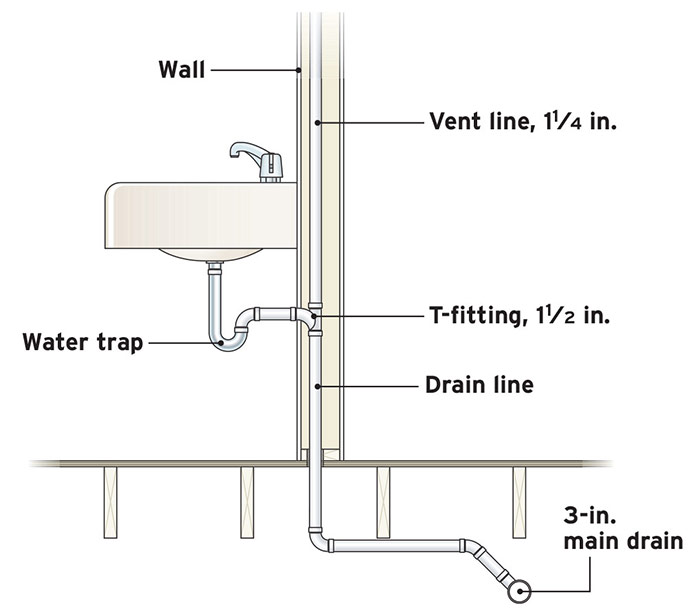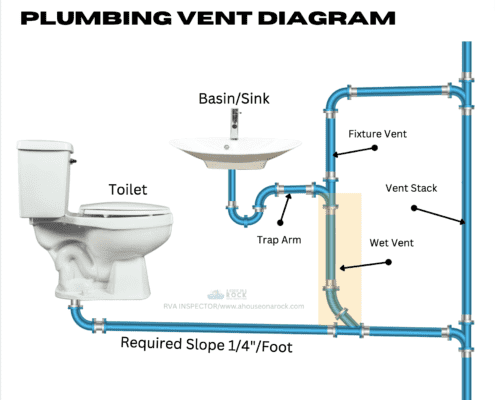How Proper Ventilation is Essential for Plumbing Systems
How Proper Ventilation is Essential for Plumbing Systems
Blog Article
The author is making a number of great points about The Upsides of Proper Ventilation in Plumbing Design in general in the content just below.

Proper ventilation in pipes systems is typically overlooked, yet it is important for keeping the functionality and security of your home's pipes. Air flow helps regulate air pressure, protect against the buildup of dangerous gases, and make certain the reliable elimination of waste. In this overview, we will certainly discover the significance of proper plumbing ventilation, just how it works, and the advantages it gives your plumbing system.
Comprehending Air Flow in Pipes
Air flow in pipes refers to the network of pipes that permit air to flow through the drain system. These vents serve several objectives, consisting of controling air pressure within the pipelines, avoiding sewer gases from going into the home, and helping in the smooth circulation of wastewater.
How Air Flow Functions in Plumbing Equipments
Atmospheric Pressure Policy
Proper air flow maintains well balanced air pressure within the plumbing system. When water moves through pipes, it displaces air. Without ample ventilation, this displacement can produce unfavorable stress, bring about slow drains or siphoning of water from catches, which can create unpleasant odors to permeate into the home.
Preventing Drain Gas Buildup
Among the most essential features of pipes vents is to stop sewer gases, such as methane and hydrogen sulfide, from gathering within the home. These gases can position major health and wellness dangers and are extremely combustible. Vent pipelines permit these gases to leave securely outside.
Assisting in Waste Removal
Ventilation helps in the reliable elimination of wastewater by stopping airlocks in the drainage system. When air can flow freely via the vents, it permits water and waste to flow smoothly via the pipes, lowering the risk of obstructions and back-ups.
Sorts Of Pipes Vents
Main Stack Vent
The primary stack vent, also known as the air vent stack, is the primary air vent in a plumbing system. It extends from the primary drain align with the roof, allowing gases to run away and fresh air to go into the system.
Branch Vent
Branch vents connect to the main pile vent and offer specific components, such as sinks, bathrooms, and showers. These vents ensure that each fixture has appropriate air flow to function effectively.
Air Admittance Valve (AAV).
An Air Admittance Shutoff (AAV) is a one-way shutoff that enables air to go into the plumbing system without the demand for a typical air vent pipe extending through the roof. AAVs are typically used in improvements or areas where installing a basic vent is not practical.
Indicators of Poor Air Flow in Pipes.
Slow Draining Fixtures.
If your sinks, bathtubs, or toilets are draining pipes gradually, maybe a sign of poor air flow. Poor air circulation can develop a vacuum cleaner effect, making it tough for water to drain correctly.
Gurgling Appears.
Gurgling noises originating from drains pipes are typically an outcome of air being drawn via water traps as a result of unfavorable pressure in the pipes. This is a clear sign of insufficient ventilation.
Undesirable Odors.
Drain smells inside your home are a warning that your pipes system is not appropriately ventilated. This might indicate that sewage system gases are not being sufficiently vented outside, causing possibly dangerous problems.
Typical Air Flow Mistakes.
Inadequate Vent Sizing.
Using small vent pipes can bring about inadequate air circulation and pressure imbalances in the system. It's important to utilize vents that meet the details needs of your plumbing system.
Improper Vent Placement.
Positioning vents too much from the components they offer can reduce their efficiency. Appropriate positioning makes sure that air can move easily and effectively through the system.
Ignoring Code Needs.
Building codes offer particular standards for pipes ventilation. Disregarding these codes can lead to a system that fails to operate appropriately and may cause pricey repairs or carcinogen.
Advantages of Appropriate Ventilation.
Boosted System Effectiveness.
Effectively ventilated plumbing systems operate a lot more efficiently, with less clogs, faster draining pipes, and less pressure on the pipes. This performance extends the life expectancy of the pipes system.
Improved Air High Quality.
By stopping sewer gases from entering your home, proper ventilation adds to better indoor air quality, making your living environment healthier and extra comfy.
Avoiding Water Damages.
Adequate ventilation helps stop water from being siphoned out of catches, which can cause sewage system gases getting in the home and triggering water damage over time.
Actions to Make Certain Appropriate Ventilation.
Consulting Plumbing Codes.
Constantly seek advice from regional plumbing codes when developing or customizing your pipes system. These codes provide the necessary standards for appropriate venting and guarantee your system meets safety criteria.
Routine Evaluation and Upkeep.
Routine inspections can aid determine potential ventilation concerns before they come to be major troubles. Maintenance jobs, such as cleaning vent pipelines and checking for obstructions, are important for maintaining the system in good working order.
Expert Setup.
For brand-new installations or major adjustments, it's wise to work with a specialist plumber. They have the proficiency to make sure the air flow system is properly developed and set up according to code.
Final thought.
Appropriate air flow is a vital element of any kind of pipes system, guaranteeing that it functions successfully and securely. By understanding the importance of ventilation, identifying the indicators of poor air flow, and taking actions to preserve your system, you can prevent costly issues and secure your home's air quality.
Understanding the Role of Your Plumbing Vents in the Drainage System
The plumbing system in your home is more than just the kitchen sink, toilet, and bathroom. Some problems that arise within home plumbing are hard to detect because homeowners may not understand potential causes.
One part of the plumbing system that could cause you endless problems is the venting. The drain lines that run through your home and drain wastewater need proper venting to function properly. Faulty plumbing vents can lead to several problems that require the expertise of a plumber to check them out. Before finding experienced plumbing services, there are a few things to learn about plumbing vents.
Why vents are vital
Vents in the plumbing system lead to an outside area such as the roof or the back. The function of these vents is to keep sewer gases away from the drain pipes. They also establish seals in the drainage pipes that prevent the sucking back of waste gases into the home. Venting in the plumbing system also allows oxygen to get into the drainage system, which is an essential component in the breakdown of waste matter. The vents also ensure that the air pressure within the drainage system remains balanced, facilitating the flow of wastewater.
Possible problems
When the plumbing vents are problematic, one of the consequences is imbalanced water levels in the toilet. If you notice that the levels in the toilet bowl rise and fall all the time, then there may be something wrong with the vents.
Another issue is air bubble formation within the toilet. In most cases like these, the drain pipes are not receiving enough air. Lack of air pressure equalization is what leads to water flow problems. If you come across such issues in your home, make sure you call professional plumbers, such as the ones from Perfection Plumbing & Drain Cleaning Ltd.
Potential causes
Several scenarios can lead to some of the plumbing problems that homeowners suffer because of venting. One such scenario is the use of incorrectly sized vents. Usually, vents are the same size as the drain line to facilitate proper venting. Vents that are too small will lead to some plumbing issues. Another potential cause is fixtures that are not close enough to the vents. In this scenario, air forces itself through the traps of other fixtures, leading to gurgling sounds from toilets and sinks.
Most of these problems also happen with clogged vents. Tree leaves and debris can cause clogging when they make their way down a vent. Unclogging plumbing vents is a service that you can entrust to Saskatoon plumbers. They will know how to snake down vents and remove clogging stuck in fixtures.

Do you really like more info about Essential Plumbing Vent Pipes: Understanding Their Role? Leave a short review down below. We will be delighted to hear your thoughts about this write up. Hoping that you visit us again in the future. Are you aware of someone else who is enthusiastic about the subject? Feel free to share it. We appreciate your readership.
Click Here Report this page